|
2013 Riding Season |
|
2013 Earth Day Plans We're helping to plan a Fuel Economy Challenge to celebrate Earth Day 2013. Fuel Economy Challenge  |
|
Charging at Campsites Here are some pictures of voltages at a typical modern campsite electrical hook up. An RV30 amp can be split into two 15A 110VAC outlets, and RV50 into four 10A 110VAC outlets. 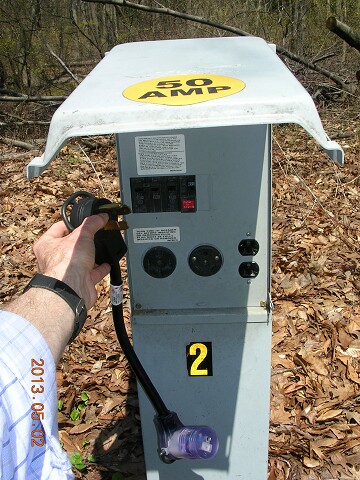 With two $16.95 pigtails from Menards (the RV 30 one modified as shown) allows plugging into an RV50 or an RV30 to get 110VAC. 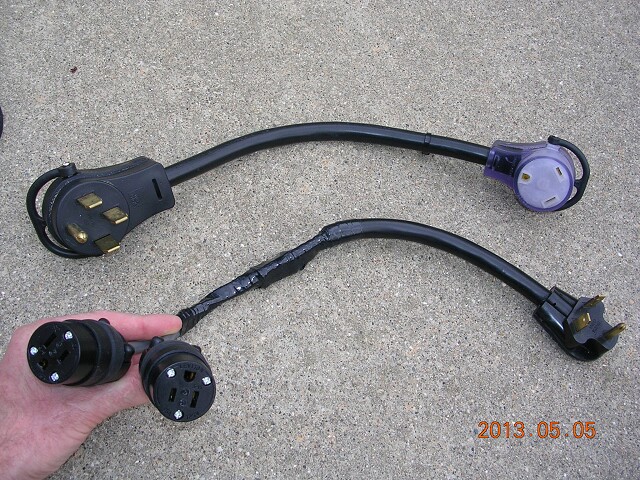 Here's a picture of an RV50 split into four 110VAC outlets of 10A each. 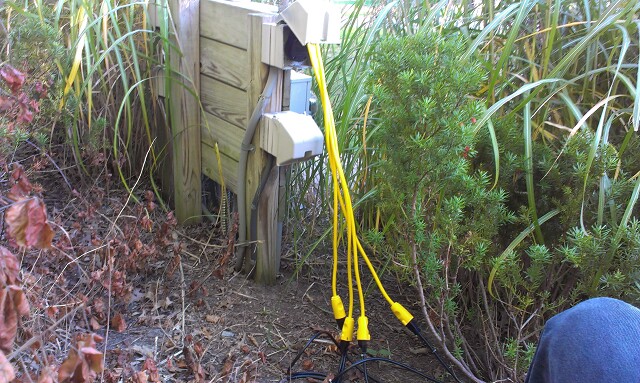 With four chargers hooked up, Delta-11 can recharge at a rate of around 40-50 miles per hour. This requires 4 separate 110VAC plug-ins, or one J1772 plug in, or one RV50 Plug in. 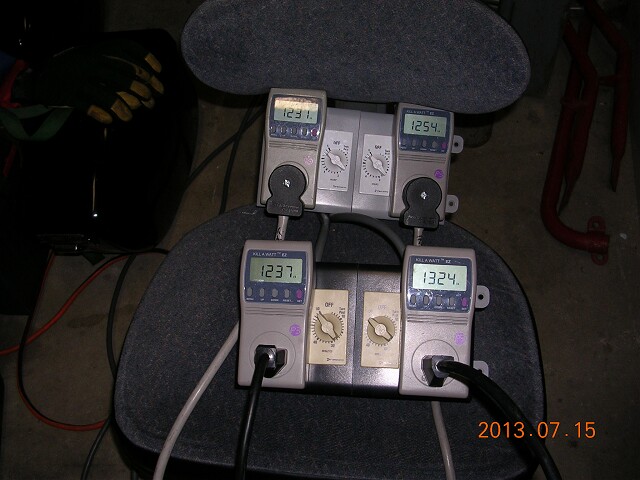 Here is picture of D-11 being charged in Calder Plaza from a RV50 outlet at 40-50 miles per hour! 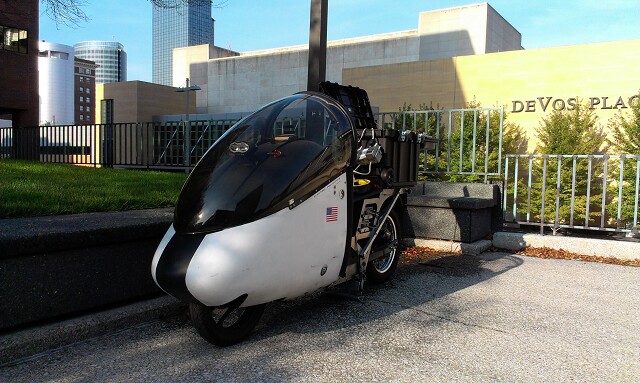 From an August 2013 e-mail written by Kraig Schultz regarding how to measure and pay for EV consumption when on the road: I believe it is important that we have a dialog with the RV park managers whenever we use their equipment to charge. This will help them understand the profit opportunity of electric vehicle charging. There are lots of ways to measure the amount of electricity used and lots of ways to determine how much should be paid for the electricity. I know people without EV's are quite concerned about electric vehicles getting their electricity for "free" or below market rates. Measurement of Energy Use (In order of preference 1 is best, 5 is worst): Method 1: If user is using 110VAC powered chargers it would be simple to put Kill-A-Watt EZ brand meters in line with each charger to record energy consumption. This is what I do whenever charging at 110VAC. These meters not only measure voltage, amps, watts, they also allow you to enter the electric rate and they display in $ how much energy you have consumed. I love them. Method 2: Allow user to convert on-board energy usage to from the wall usage. EV'ers should install energy usage devices on their vehicles. Meters like a Cycle Analyst are critical for getting real time feedback when working to improve aerodynamics. http://www.ebikes.ca/store/store_CA.php The drawback of this method is the user must have data to support his recharge efficiency numbers. My charge efficiency is 77%. This means that whatever I pull from my batteries I must add an extra 23% to recharge. The two big losses that make up recharge efficiency are charger inefficiency and battery chemistry inefficiency. Method 3: The charge point stations display the amount being given when they are being used, so EV'ers should know from experience exactly how much each of their chargers pull from the grid when charging. With this knowledge EV'ers can calculate, based on how many chargers they have plugged in and how long they are plugged in how much power they "borrowed" from the outlet. This method requires that the rider had data from past rides and keeps accurate recordings of how long he was plugged in during the recharge. Method 4: The RV50 plug has circuit breakers on it. It can give a maximum of 50 amps at around 220 volts RMS. So, that is around 11,000 watts per hour maximum that it can supply. We can assume worst case, the electric vehicle is using 11 kWh whenever plugged in. For the competition, the user must report 11,000 watts/hour x number of hours plugged in. Method 5: Battery Size Method: If I know my battery pack can hold 18 kWh, and my recharge efficiency is 77% and the going rate is $.12/kWh, then the worst case fill-up cost would be: (18 kWh x $.12/kWh) / .77) = $2.80 In this scenario, the electric vehicle would be "charged" $2.80 any time it hooks up to charge. We don't know how much it got from the grid, but it couldn't have been more than $2.80 per charge. How Much Should Be Paid (in order of preference, 1 is most preferred): 1. Opportunity Cost Method #1: If the RV50 outlet is being used by an electric vehicle, then it can't be used by someone else. The most power we can sell out of the outlet is 11 kWh, so the rate might be calculated something like this (assuming $.12/kWh rate, and a surcharge of 25% for upkeep and administration of the outlet): 11kWh x $.12 x 125% = $1.65 per hour. 2. Friendship Sharing Method: (The going rate the campground pays) x (what you feel you used) + (15% tip). 3. Opportunity Cost Method #2: If the RV50 outlet being used prevents the RV park from renting a parking spot to an RV for that day, then the electric vehicle should have to pay the going rate for the slot for the day. 4. Free? NEVER. Electricity is not free and EV'ers should always attempt to pay our fair share when using someone else's electricity. |
|
Eco Modder Site Visit the Eco Modder Site to see what experiments people are doing. Click here to see Delta-11 Fuel Log. |
|
Video of Delta-11 on Highway - May 18, 2013 Click here for a YouTube Video of the Delta-11 on the highway.  |
|
Terry Hershner Completes Epic Journey - June 5, 2013 Terry Hershner rode his electric motorcycle solo across the USA, History Books will record this an important seachange. For more details, click here 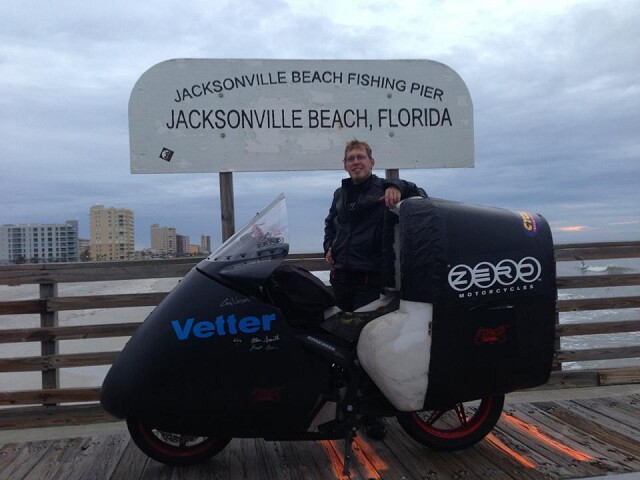 |
|
Navigation System Installed June 6, 2013 Smart Phone with extra battery pack made a wonderful addition to the Delta-11 dashboard added June 6. Also, notice the twisted wire cruise control on the throttle added June 23. Thanks to Terry Hershner for these ideas.  |
|
Gilmore Bike Show Ride - June 9, 2013 Rode out to Gilmore Bike Show on Sunday June 9th. It was a 128 mile ride. Stopped in Plainwell to charge and ran into the first chargepoint actually being used to charge an electric vehicle (other than the Delta-11). 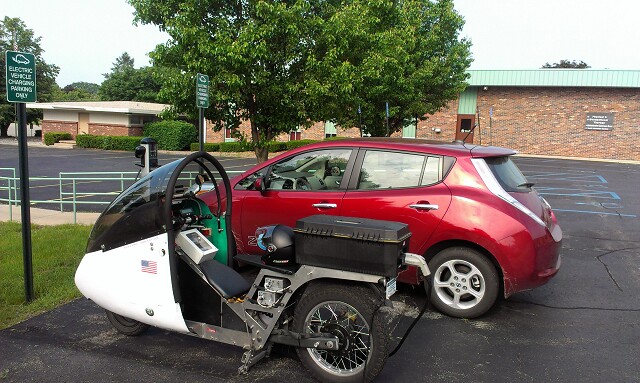 On the way home trying to avoid the rain, I ran into wet roads, water slung from rear wheel was sucked up into electronics area, suspect power supply for controller got damp. Pulled over and opened up covers to let it air dry. After 45 minutes it was dryed out and rode it home. 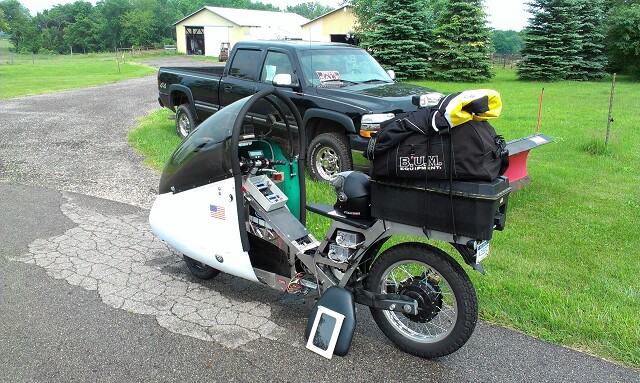 |
|
Use BugE Nose as a Tail? June 14, 2013 Experimenting with various tail ideas...BugE tail worked, but was large, ugly and access was not good. 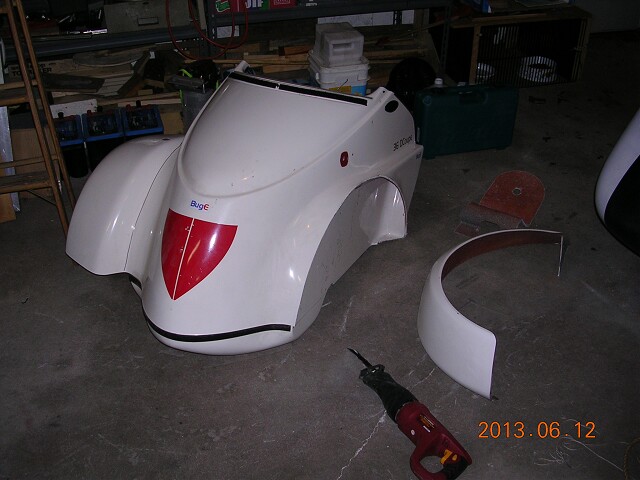 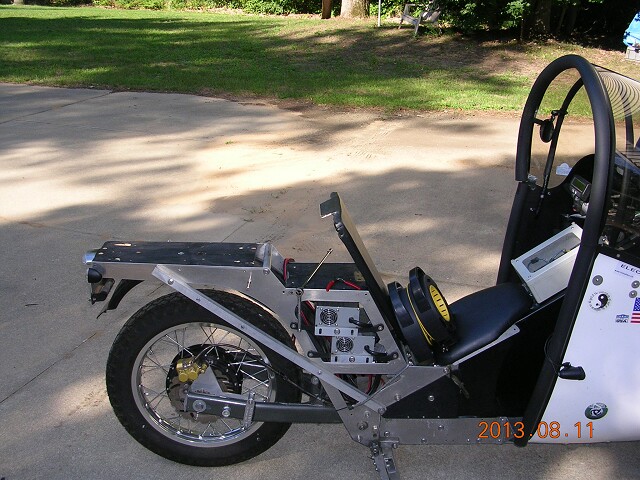 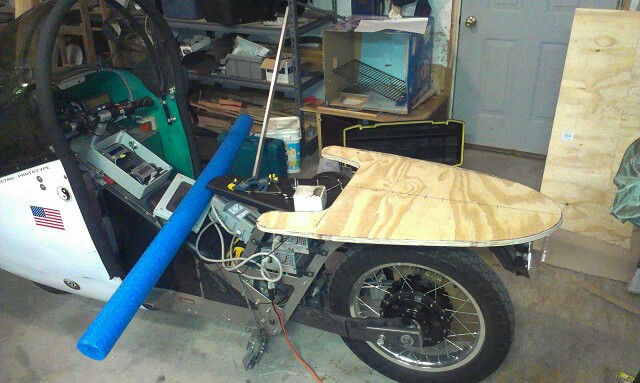 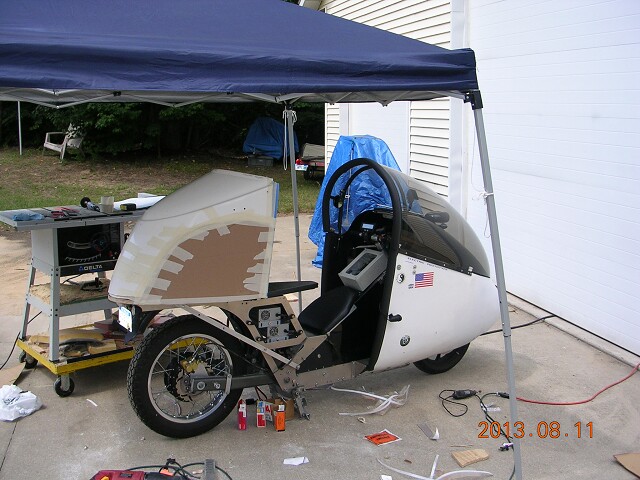 Saddle bags were ok, but floppy in the wind, need better brackets to hold them and would like them to be bigger. 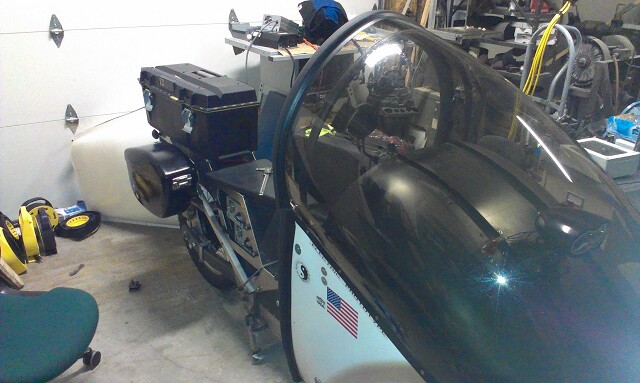 |
|
Electric Bicycle Test Ride June 16, 2013 Did a ride with my son on his Linear Electric Bicycle. The numbers of the two bikes are as follow for a 24 mile ride at 21.5 mph Average Speed: Linear Bicycle - with 140# Rider not pedaling: 38.6 Wh/Mile from the wall Delta-11 - with 200# rider: 57.2 Wh/Mile from the wall  For more information on the Linear Bicycle Visit the EvAlbum Site. Linear Electric Bicycle. |
|
Nose Bolts Broke - June 28th, 2013 1/4-20 threaded rod holding nose support broke after 7,500 miles. Installed larger diameter rod and more of it. 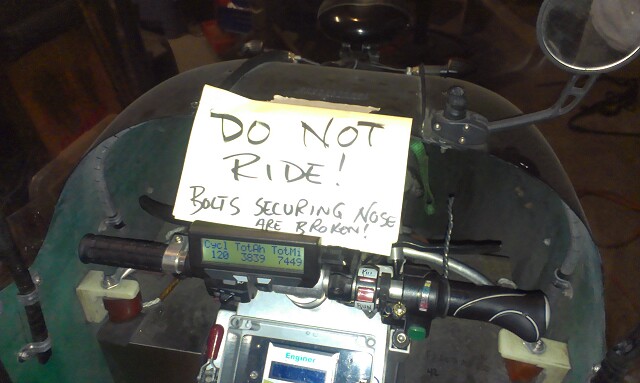 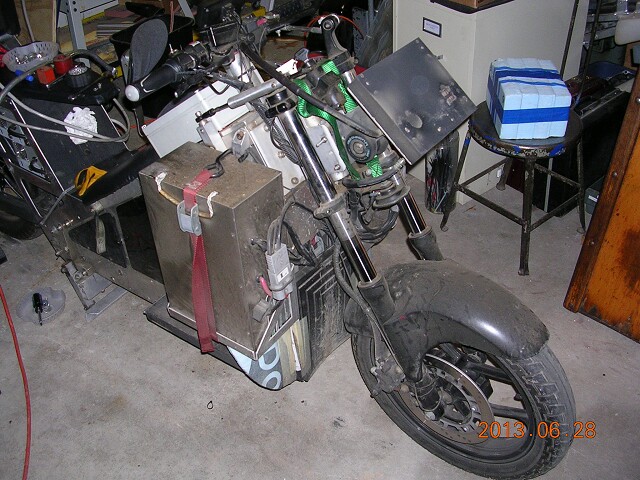 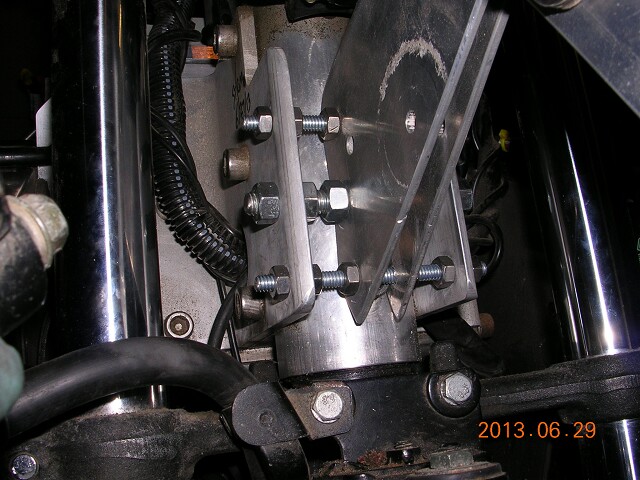 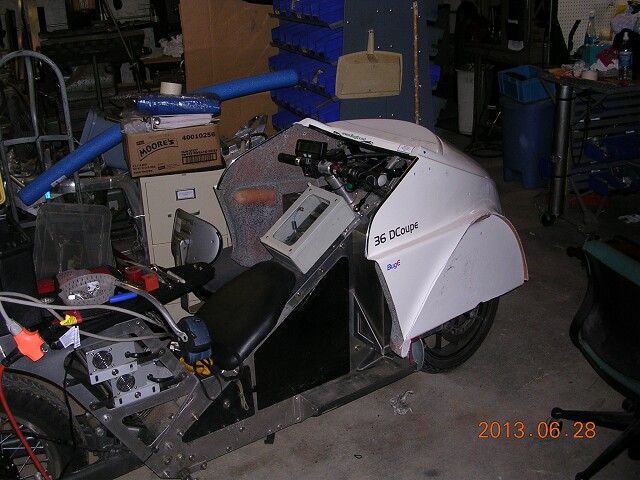 |
|
Some of Kraig's Favorite Bikes at Hollywood Electrics - June 26, 2013 Got to visit Hollywood Electrics during a recent business trip. Saw a Duel Hub Motor Tandem and a bike named Big Blue. 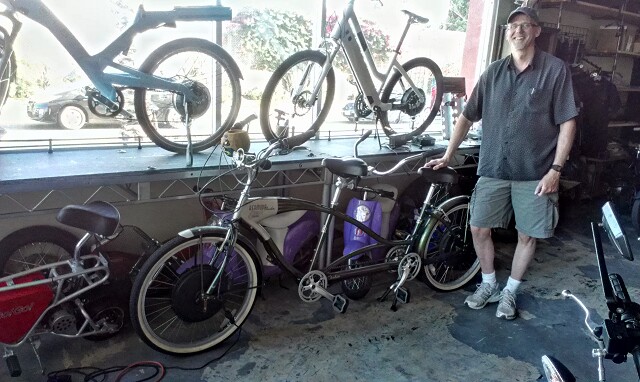 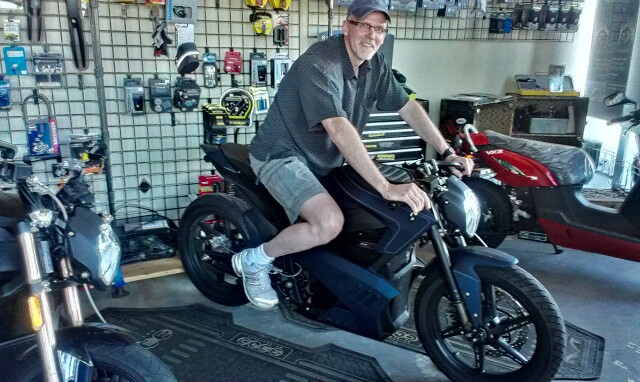 |
|
Vintage Days 2013 Report July 19-21, 2013 Due to work schedules, Schultz Engineering and the Delta-11 did not attempt to ride in the 2013 Mid-Ohio Challenge. Kraig and Maggie did however attend Saturday and Sunday to spend some time with the participants. Due to stormy weather the Delta-11 was trailered down Friday night. 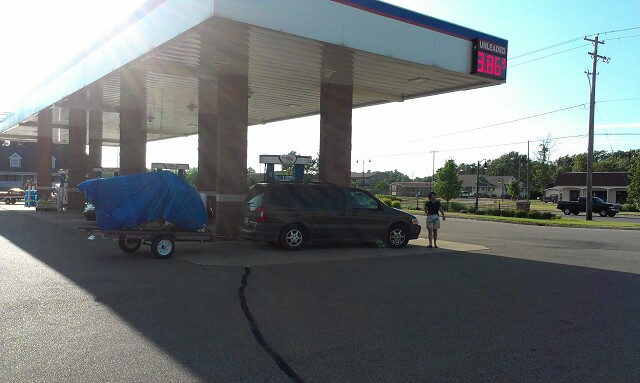 Official results from Craig Vetters site 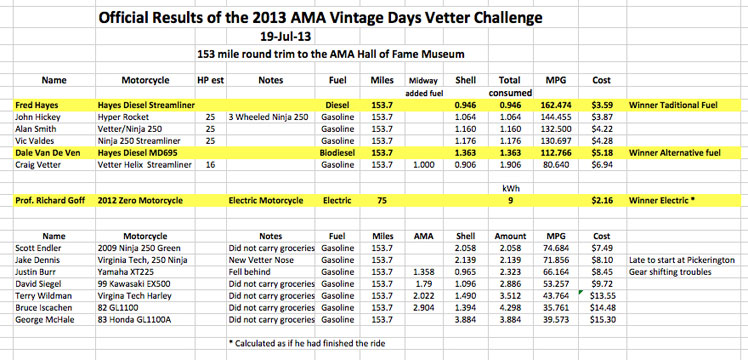 The true winner of the event. Richard Goff's Stock Zero DS (with DS tires & ZF9 battery) with a HUGE cardboard box strapped on the back and windshield taped on the front. He rode 75 miles at highway speeds with that box! Impressive. Unfaired, he beat the fuel economy of all the fossil fueled bikes. 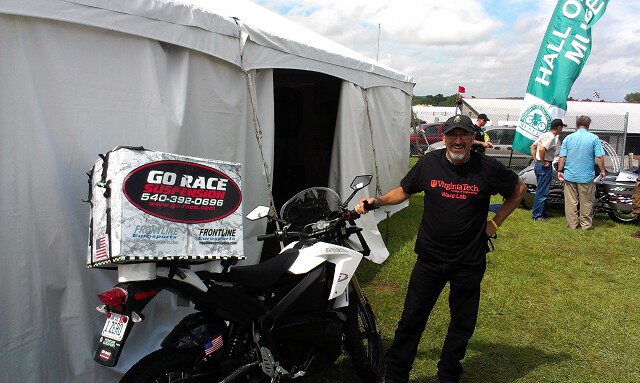 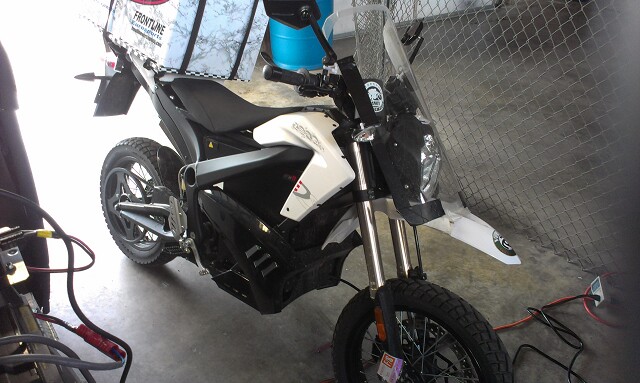 D-11 and the Craig Vetters Bike for size comparision - it's hard to catch Craig Vetter standing still! 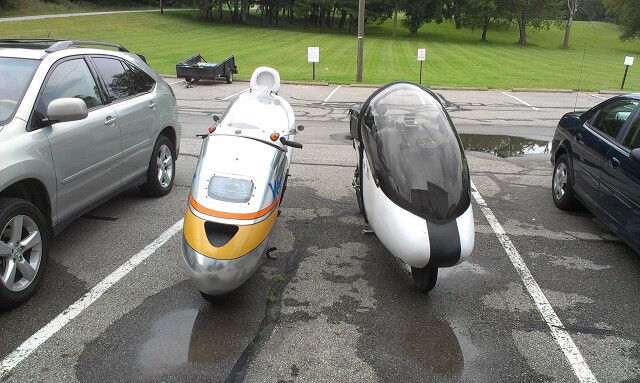 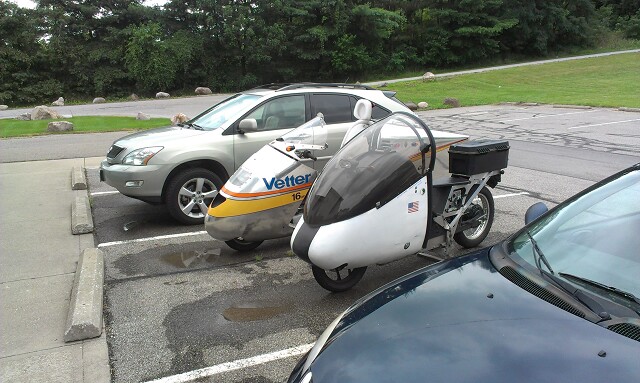 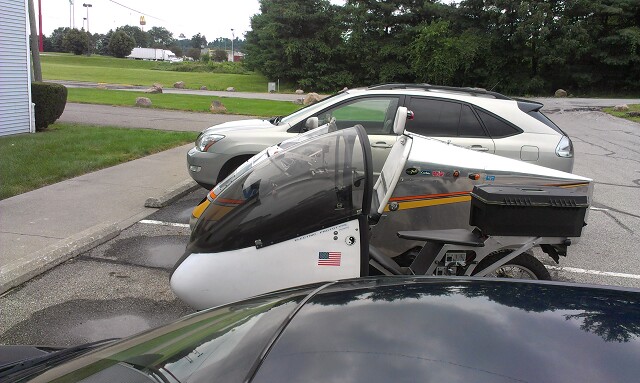 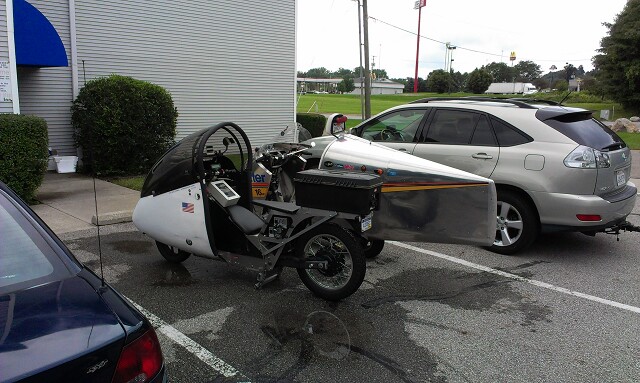 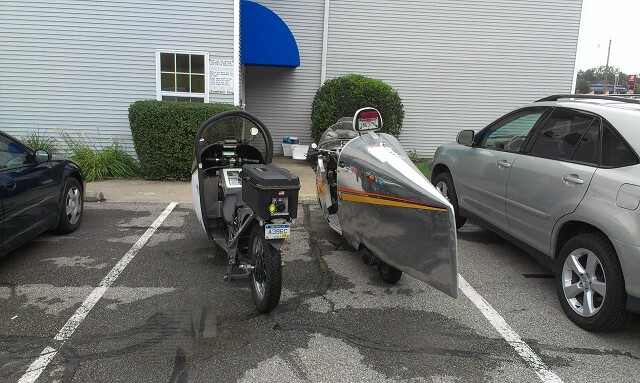 Before dinner Saturday night, Kraig Schultz, Craig Vetter, Alan Smith and Vic Valdes review the Delta-11 two position riding seat. 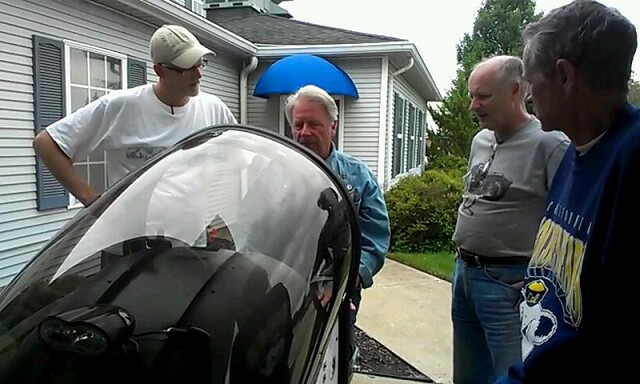 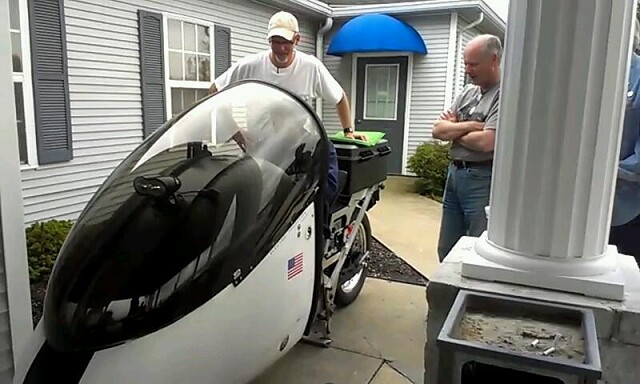 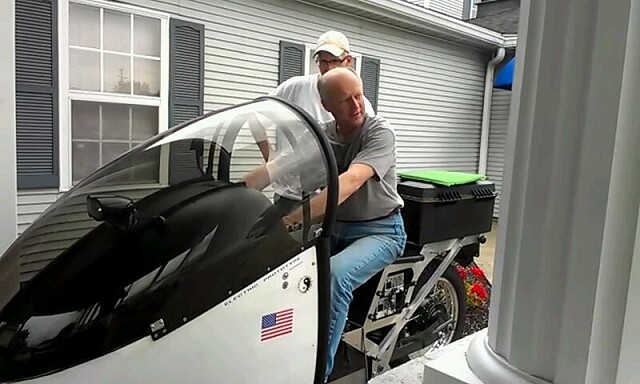 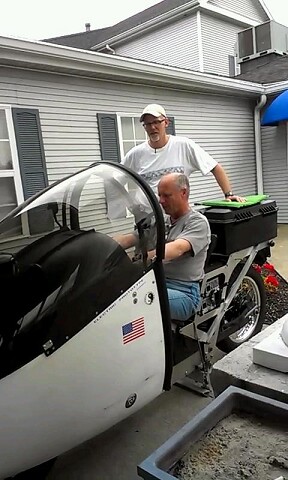 Stopping point during Sunday morning ride. We started at hotel and finished at Mid-Ohio Track. Ride statistics from Delta-11 Cycle Analyst: 34.9 Miles, 45.3 mph average speed, 70.5 mph max speed, 88.5 Wh/mile. (D-11, Alan, Vic, and Richard) 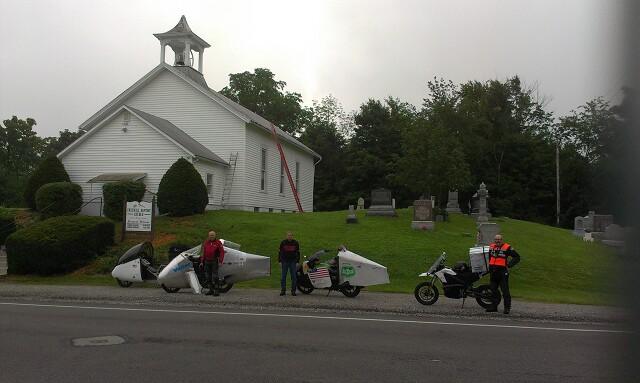 Richards Team 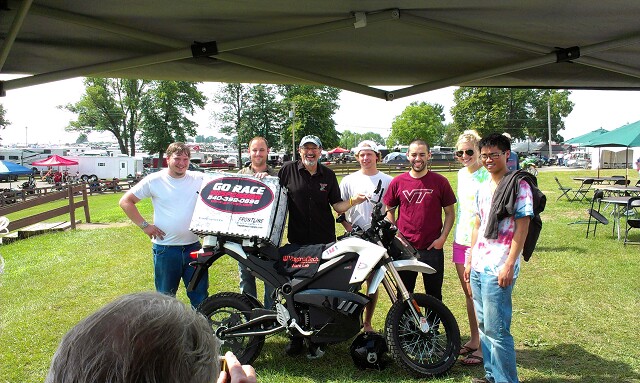 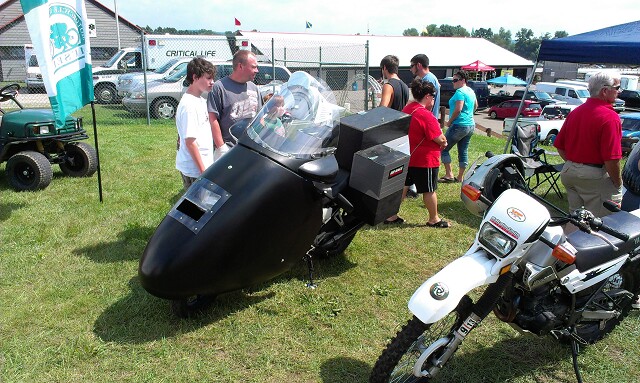 Streamliner line up 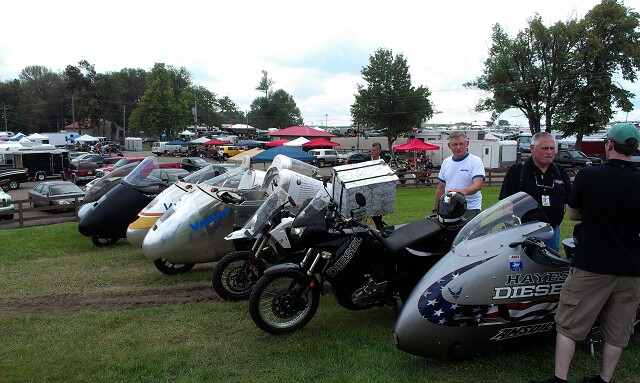 Ride home - problems getting all four chargers working at first two stops, so ride aborted at Findlay, OH - recharge time too long - won't get home in time for work Monday. 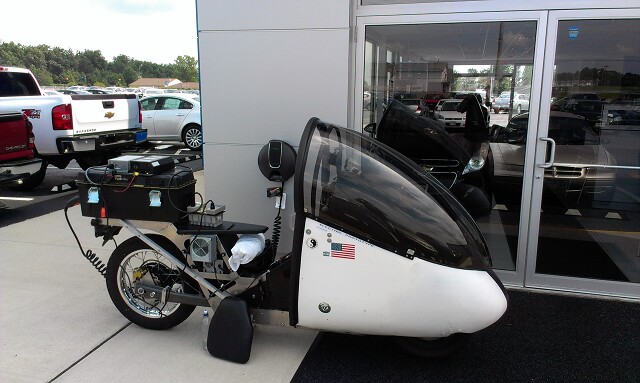 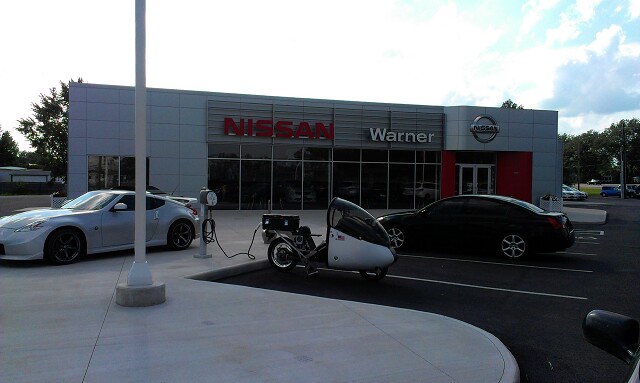 |
|
Larger Trunk Installed - August 24, 2013 Here is a new larger trunk 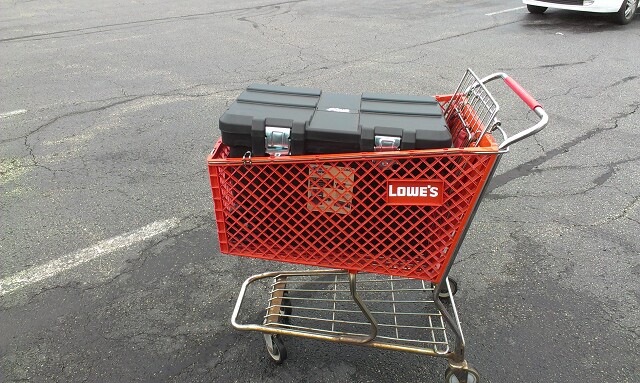 Various charging gear can take a lot of storage space on an electric motorcycle. 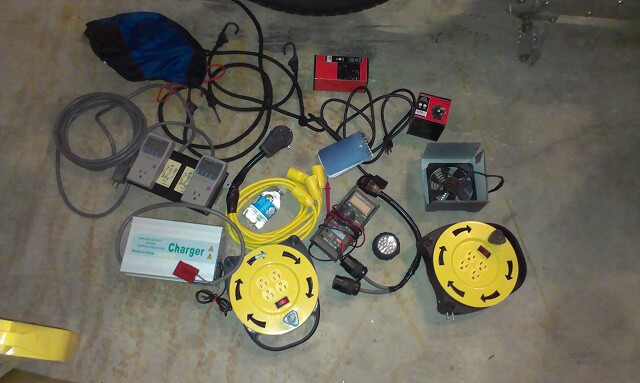 |
|
Peace Ride - August 20, 2013 To test new trunk, rode to Kalamazoo and back (141 miles) for a Peace Walk Gathering. Used13.1 kw-hrs for trip = 92.9 Wh/Mile (from the wall), so the big trunk is not hurting fuel economy all that bad. Cross wind stability was also good. 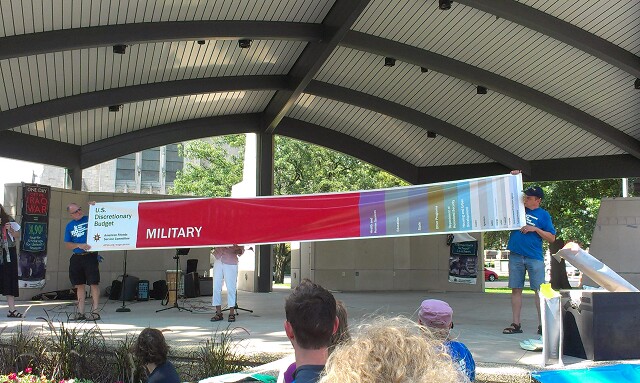  Picture of first time paying for electricity at a public charging station. $.20/hour. We charged 2.5 hours, got 3.41 kw-hrs for $.50 or $.147/kw-hr. 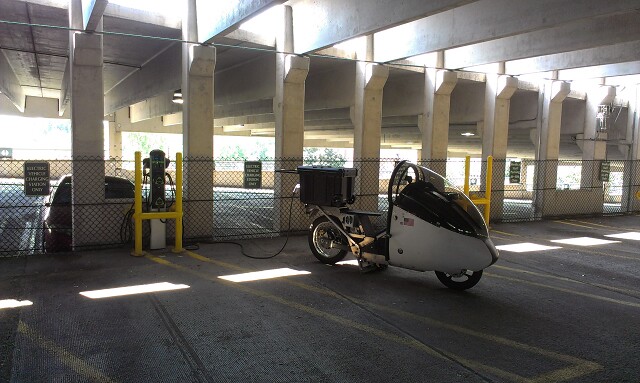 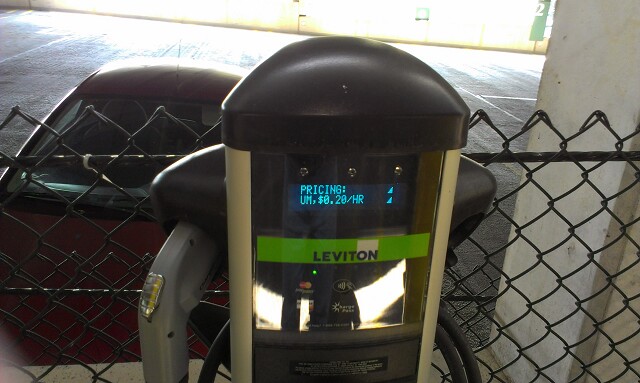 |
|
Dan Raymond Park Ride (114 miles) - Sept. 22, 2013 Rode up to Grant Michigan to check out the Dan Raymond Park Hill Climb event, then rode over to Grand Rapids to Visit Art Prize with my Family. Along the way, found an awesome place to fast recharge at the Conklin Park Pavilion in Ravanna. This Pavillion was wired well, with a separate 20 amp circuit breaker for each of the six 110VAC duplex GFI outlets spaced around under the Pavilion.  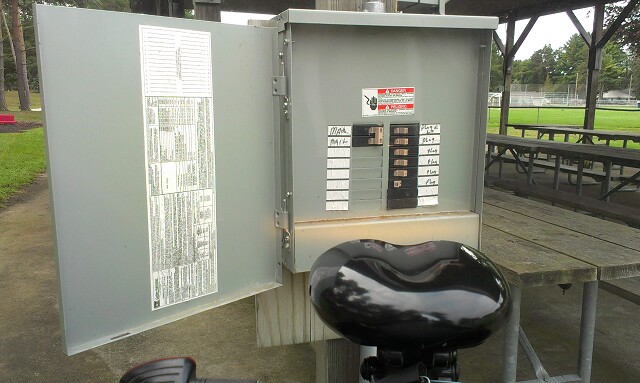 The Wall, motorcycle hill climb hill. Someone definately needs to build an electric hill climb bike - it's a perfect venue - short run, high power. I think a front wheel drive machine might be in order. 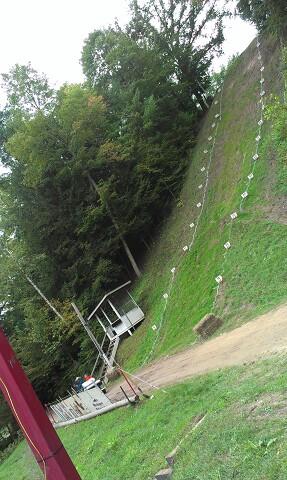 A good message from an artist at Art Prize. It was hanging from a geodesic dome framework. Note the quote is from Buckminster Fuller.  |
|
Plug In Day Ride (170 Miles) - Sept. 28, 2013 To celebrate Plug In Day, the Delta-11 did fast charging in Holland, South Haven, Kalamazoo and Grand Rapids during a 170 mile ride. The highlights of the ride were the visit to the Solar Panel Powered charging station at WMU and a test ride of the 2013 Zero DS at Life Cycle in Kalamazoo. Here is the tour route: View Larger Map Lots of leasons learned from the ride. Here are a few: 1. The roads I traveled on this route were very bumpy - need to select smoother roads that give same destinations for less wear and tear on the rider and equipment 2. 170 miles makes for a long day. Left at 7:40am and returned home at 7pm. Should make a tour 40 miles out and 40 miles back. 3. D-11 needs better suspension and seat padding - my back is fatigued! 4. Solar Array at WMU was worth the trip 5. 2013 Zero DS has powertrain nailed. Ergonomics, brakes and suspension? 6. Fast Charging (4,000 watts) = recharge times that made the bike fully charged before the human was done at each stopping point 7. It takes a lot of room to haul stuff for doing 4 chargers at 110VAC and 220VAC (4 extension cords, 2 extra chargers), need those installed into nooks and crannies of bike 8. It takes about 5 minutes of fiddling and hooking up to plug into fast charging 9. Another mis-use of EV charging parking spots = EV's parking in EV spot but NOT plugging in to charge, or staying hours after charging is complete 10. If doing an EV road rally, destinations could be identified and each vehicle given a unique road Rally sticker for the side of their vehicle. Each vehicle would need to get a picture of their vehicle with the sticker at each destination point. 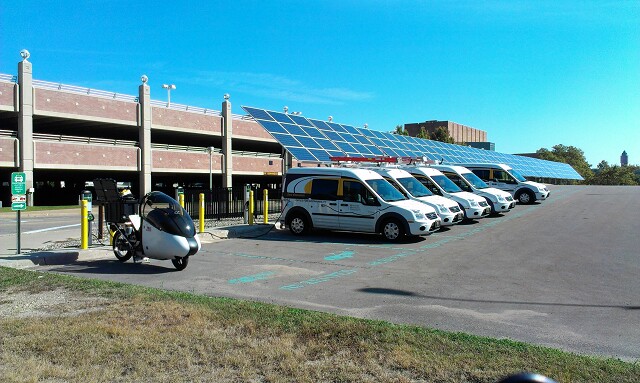   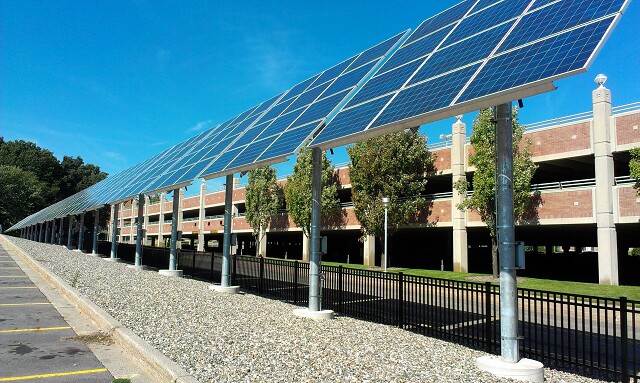 Earl's Farmers Market, 1630 Blue Star Hwy Fennville/Glenn, MI 49408 is a good pit stop for fresh baked goods, fruits, vegtables, canned goods and they have an ice cream shop. In addition, they have a lot of power outlets on the outside of their building that with permission might make a good place for a charging stop in a future tour.  The test ride of the 2013 Zero DS verified that Zero has nailed the power train for an electric motorcycle. The bike is extremely fun to ride and the powertrain has awesome acceleration and nicely tuned "engine braking" regen. Kraig recommends that anyone interested in electric motorcycles should take a Zero for a ride - it's a proven solution and it can be purchased and ridden today. 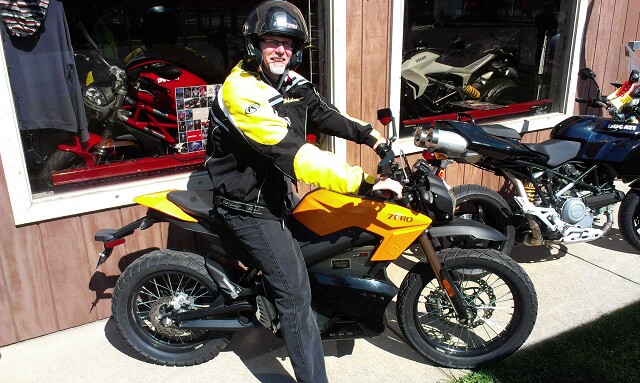 |
|
D-11 Turns 10K - October 13, 2013 The Delta-11 Prototype just turned over 10,000 miles. Pretty good for a bolted together prototype frame. The battery's are starting to show their age, had to interrupt a ride at 40 miles today just to charge, used to be able to go 50-60 miles at the same speeds. Time for a new bike or just time to upgrade the batteries? 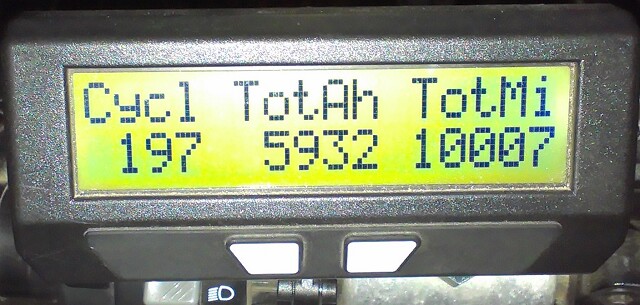 Some things are not as good as they look. The 10,007 miles is correct, the Cycles and AH are not. The Cycle Analyst gage was installed in April 2012 when the bike had 2,727 miles on it and the cycle count and AH started at Zero at that time. So, with a little math we can calculate some interesting statistics. 10,007 Miles - 2,727 Miles = 7,280 Miles / 196 Charge Cycles = 37 Miles/ Charge Cycle. 5932 AH x 99 volts / 7,280 Miles = 81 Wh/Mile. 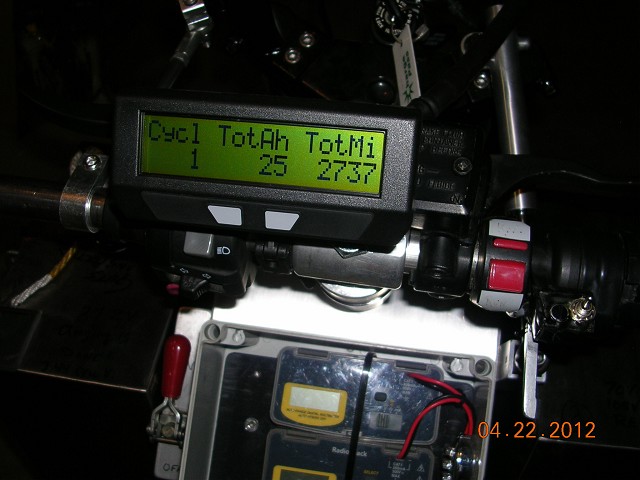 55mph, drawing 4.7kW, flat road, speed control engaged. 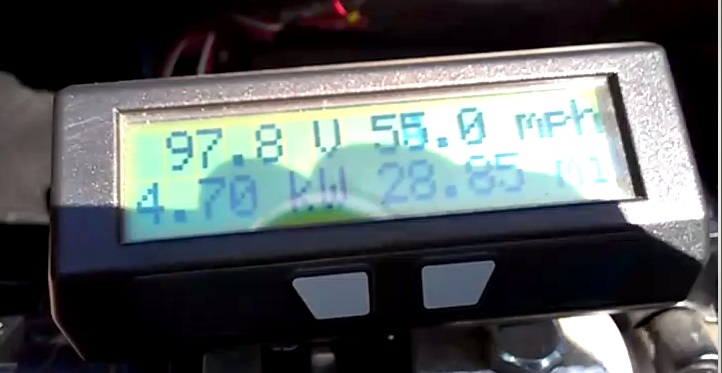 68mph, drawing 6.35 kW, flat road, speed control engaged. 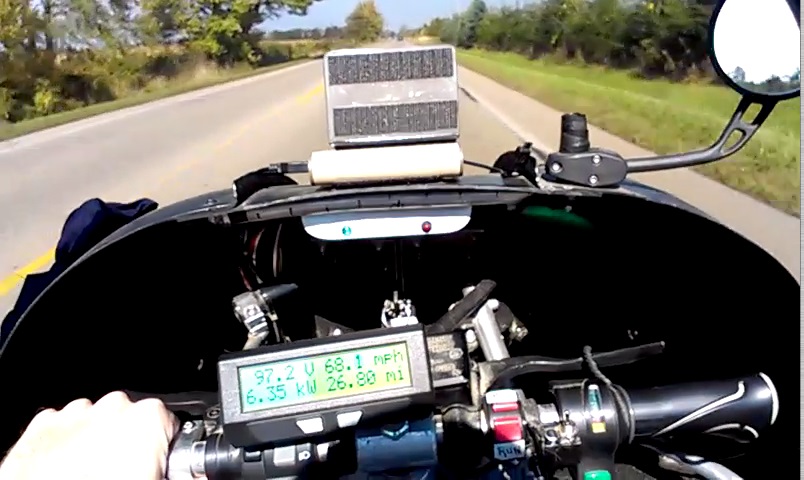 State After ridden 10,000 miles. 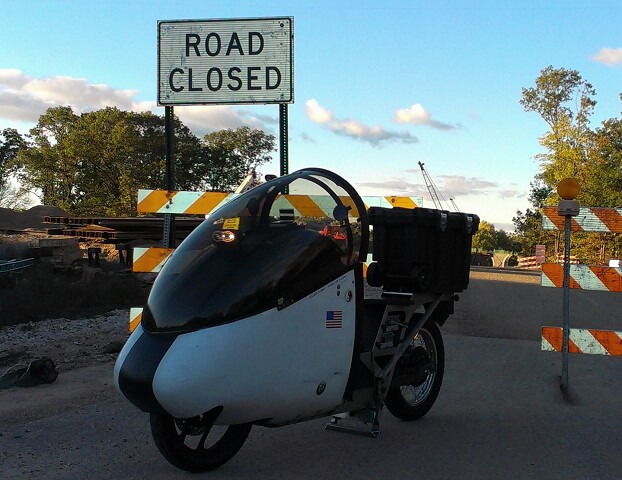 |
|
November ASM Talk 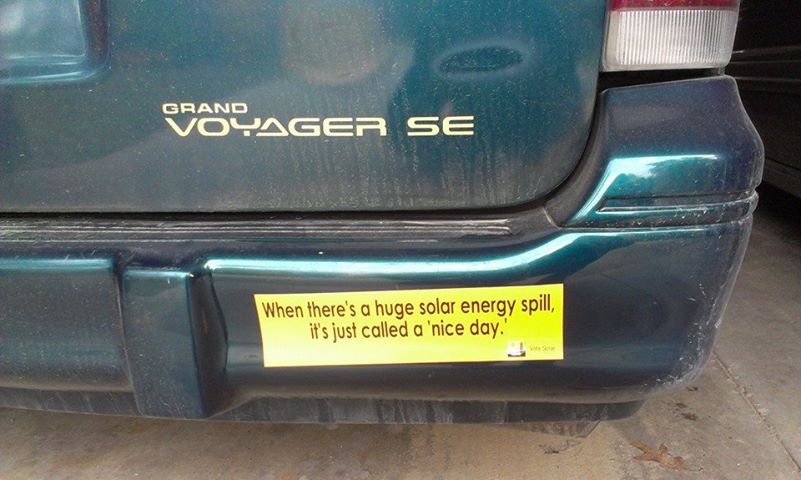 |
|
(Next Page) |
|
Inventing a better tomorrow today... Copyright 2012-2013, Schultz Engineering, LLC, written by Kraig Schultz |